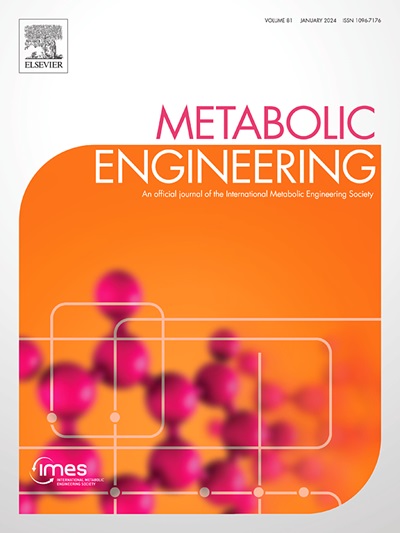热细胞活动弧菌(Clostridium thermocellum)嗜热l-阿拉伯糖诱导体系的建立。
IF 6.8
1区 生物学
Q1 BIOTECHNOLOGY & APPLIED MICROBIOLOGY
引用次数: 0
摘要
诱导型遗传操作系统是微生物合成生物学和代谢工程的重要工具。然而,非模式微生物,特别是嗜热菌的诱导系统很少被报道。热细胞活动弧菌(以前称为热细胞梭菌)是一种具有代表性的嗜热非模式微生物,目前在生物炼制中是一种很有前途的基础生物。虽然有多种遗传工具可用于热细胞芽孢杆菌,但对优良的嗜热诱导系统的需求很大。在这项研究中,我们利用嗜热脂肪地杆菌T-6的诱导启动子PabnE和抑制子AraR,在a . thermocellus中建立了一个耐热的l-阿拉伯糖诱导体系(ThermoARAi)。通过系统启动子工程和以耐热β-葡萄糖醛酸酶为报告因子的诱导条件优化,系统的动态范围从5.4倍诱导提高到175倍诱导,且泄漏可以忽略不计。此外,ThermoARAi系统适用于代谢工程,其在纤维素底物的全细胞糖化和无定形聚对苯二甲酸乙二醇酯膜降解中的应用验证了这一点。ThermoARAi系统极大地扩展了热细胞拟南芥精确基因表达调控、代谢工程和生物技术应用的遗传工具包。重要的是,这种方法也可以作为开发其他梭状芽孢杆菌遗传工具的基础,这些梭状芽孢杆菌在包括肠道在内的各种生态系统中发挥关键作用。本文章由计算机程序翻译,如有差异,请以英文原文为准。

Development of a thermophilic l-arabinose-inducible system in Acetivibrio thermocellus (Clostridium thermocellum)
Inducible genetic operation systems constitute essential tools in microbial synthetic biology and metabolic engineering. However, inducible systems in non-model microbes, particularly thermophiles, are rarely reported. Acetivibrio thermocellus (previously termed Clostridium thermocellum), a representative strain of thermophilic non-model microbes, currently serves as a promising chassis organism in biorefinery. Although various genetic tools are available for A. thermocellus, superior thermophilic inducible systems are in high demand. In this study, we developed a thermostable l-arabinose-inducible system (ThermoARAi) in A. thermocellus by utilizing the inducible promoter PabnE and repressor AraR from Geobacillus stearothermophilus T-6. Through systematic promoter engineering and optimization of induction conditions using a thermostable β-glucuronidase as reporter, the system exhibited dynamic range improvement from a 5.4-fold induction to a 175-fold induction with negligible leakage. Furthermore, the ThermoARAi system was appropriate for use in metabolic engineering, as validated by its applications in whole-cell saccharification of cellulosic substrates and degradation of amorphous polyethylene terephthalate films. The ThermoARAi system significantly expands the genetic toolkit for precise gene expression modulation, metabolic engineering, and biotechnological applications in A. thermocellus. Importantly, this approach may also serve as a foundation for developing genetic tools in other Clostridia that play key roles in diverse ecosystems, including the gut.
求助全文
通过发布文献求助,成功后即可免费获取论文全文。
去求助
来源期刊

Metabolic engineering
工程技术-生物工程与应用微生物
CiteScore
15.60
自引率
6.00%
发文量
140
审稿时长
44 days
期刊介绍:
Metabolic Engineering (MBE) is a journal that focuses on publishing original research papers on the directed modulation of metabolic pathways for metabolite overproduction or the enhancement of cellular properties. It welcomes papers that describe the engineering of native pathways and the synthesis of heterologous pathways to convert microorganisms into microbial cell factories. The journal covers experimental, computational, and modeling approaches for understanding metabolic pathways and manipulating them through genetic, media, or environmental means. Effective exploration of metabolic pathways necessitates the use of molecular biology and biochemistry methods, as well as engineering techniques for modeling and data analysis. MBE serves as a platform for interdisciplinary research in fields such as biochemistry, molecular biology, applied microbiology, cellular physiology, cellular nutrition in health and disease, and biochemical engineering. The journal publishes various types of papers, including original research papers and review papers. It is indexed and abstracted in databases such as Scopus, Embase, EMBiology, Current Contents - Life Sciences and Clinical Medicine, Science Citation Index, PubMed/Medline, CAS and Biotechnology Citation Index.
 求助内容:
求助内容: 应助结果提醒方式:
应助结果提醒方式:


